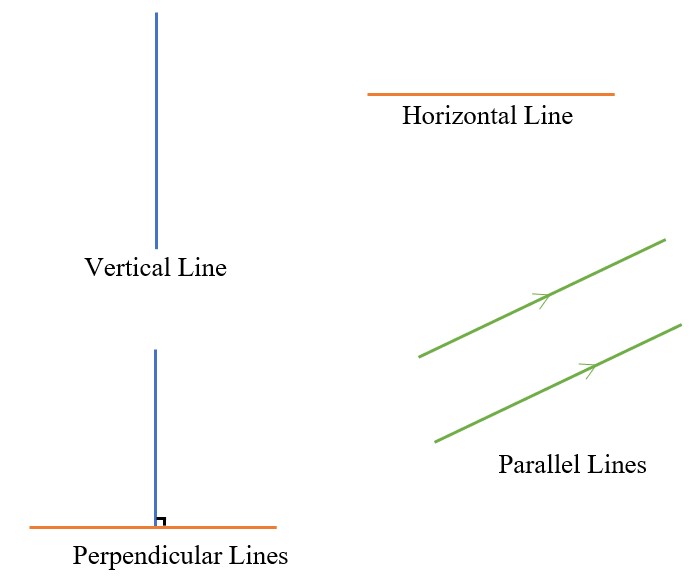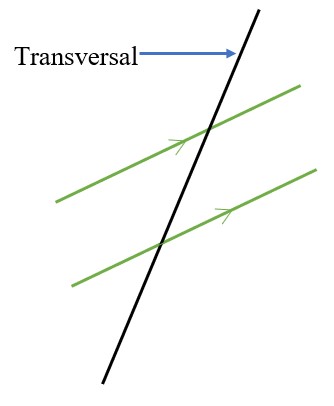LINES AND ANGLES

- Angles are formed at the point of intersection of two lines.
- Angles can be defined according to their sizes:
- Acute angle: This angle is less than 90°
- Right angle: This angle is equal to 90°
- Obtuse angle: This angle is between 90° and 180°, i.e. This angle is greater than 90° but less than 180°
- Reflex angle: This angle is between 180° and 360°, i.e. This angle is greater than 180° and less than 360°
- Complementary angles: These are angles that sum up to 90°.
- Supplementary angles: These are angles that sum up to 180°
- Perpendicular lines are lines that intersect at right angles; 90°.

- The orientation of the lines do not matter, as long as the angle between them is 90°, they are perpendicular.
- A line that cuts across two or more parallel lines is called a transversal.

- Using the diagram below to define more angles:

- Angles at a point add up to 360°. Therefore, a + b + c + d = 360° and e + f + g + h = 360°
- Angles on a straight line add up to 180°. Therefore, a + b = c + d = a + d = b + c = 180° and
e + f = g + h = e + h = f + g = 180°
- Vertically opposite angles are equal. Therefore, a = c, b = d, e = g, f = h.
- Alternate angles are equal. Therefore, c = e, and d = f
- Corresponding angles are equal. Therefore, a = e, b = f, c = g, and d = h.
- Two interior angles on the same side of the transversal add up to 180°.
Therefore, d + e = c + f = 180°
- NOTE: There might be more than one way to get a particular angle. (Check out Example 1a)
POLYGONS
- A polygon is a plane figure that is bounded by many straight lines.
- A regular polygon has all sides and angles equal.
- A quadrilateral is a four-sided polygon. Examples, square, rhombus, kite, rectangle, etc.
- Other examples of polygons:
- A pentagon has five sides

- A decagon has ten sides

- The interior angles of an n-sided polygon would add up to (2n – 4) × 90° or (n – 2) × 180°

- The exterior angles of a polygon would add up to 360°

Examples
- Determine the angles a, b, c in the following:

- To get c:
- 62° + c + 55° = 180° [Sum of angles on a straight line]
- ∴ c = 63°
- To get b:
- First step:
- b = 55° [Vertically opposite angles]
- Second step:
- b + 62° + c = 180° [Sum of angles on a straight line]
- b + 62° + 63° = 180°
- ∴ b = 55°
- To get a:
- First step:
- a + b = 180° [Sum of angles on a straight line]
- a + 55° = 180°
- ∴ a = 125°
- Second step:
- a = 62° + c [Vertically opposite angles]
- a = 62° + 63°
- ∴ a = 125°

- To get a:
- 65° + a + 47° = 180° [Sum of angles on a straight line]
- ∴ a = 68°
- To get b:
- a + b = 180° [Interior angles on the same side]
- 68° + b = 180°
- ∴ b = 112°
- To get c:
- a = Angle DEC [Corresponding angles}
- c = Angle DEC [Alternate angles]
- ∴ c = a = 68°
- Find the values of all unknown angles below:

- To get a:
- a = 40° [Vertically opposite angles]
- To get d:
- d = 55° [Vertically opposite angles]
- To get c:
- c + 55° = 180° [Angles on a straight line]
- ∴ c = 125°
- To get b:
- b + 40° = 180°
- ∴ b = 140°
- To get e:
- c + e = 180° [Interior angles on the same side]
- 125° + e = 180°
- ∴ e = 55°
- To get f:
- Sum of interior angles in a 3-sided polygon = (3 – 2) × 180° = 180°
- ∴ d + a + f = 180°
- 55° + 40° + f = 180°
- ∴ f = 85°
- To get h:
- h = f [vertically opposite angles]
- ∴ h = 85°
- To get g:
- g + e + f = 180° [Angles on a straight line]
- g + 55° + 85° = 180°
- ∴ G = 40°
- To get k:
- h + k = 180° [Angles on a straight line]
- 85° + k = 180°
- ∴ k = 95°
- To get m:
- g = m [Alternate angles]
- ∴ m = 40°
- To get p:
- m = p [Vertically opposite angles]
- ∴ p = 40°
- To get n:
- h + m + n = 180° [Sum on interior angles in a 3-sided polygon]
- 85° + 40° + n = 180°
- ∴ n = 55°
- To get q:
- Determine the value of x in the figures below:

- Sum of interior angles in a 5-sided polygon = (5 – 2) × 180° = 540°
- ∴ 120° + 70° + 45° + 45° + x = 540°
- ∴ x = 260°

- Sum of interior angles of a 6-sided polygon = (6 – 2) × 180° = 720°
- ∴ 130° + 120° + 100° + y + 130° + 140° = 720°
- ∴ y = 100°
- y + x = 180° [Angles on a straight line]
- 100° + x = 180°
- ∴ x = 80°
- The interior angles of a polygon add up to 1980°. How many sides has the polygon?
- Sum of interior angles of a n-sided polygon = (n – 2) × 180°
- ∴ (n – 2) × 180° = 1980°
- n – 2 = 11
- ∴ n = 13
- Find y in the diagram below.

- Sum of exterior angles of a polygon = 360°
- ∴ 5y + 2y + 4y + 3y + 7y + 3y = 360°
- ∴ 24y = 360°
- ∴ y = 15°














